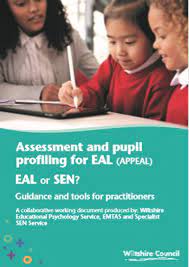The WSCC Ethnic Minority and Traveller Achievement Service (EMTAS) is keen to help schools answer the question:
‘Is it having English as an Additional Language that is presenting as a difficulty for this pupil, or are there also elements of SEN present?’
EMTAS recommends a recently published tool that can help clarify thinking around the issue. The APPEAL Tool (Assessment and pupil profiling for EAL) was developed by Wiltshire Local Authority Educational Psychologists, Specialist SEN Service and EMTAS Advisory Teachers.

The opening sections of the tool remind us that we need to first of all check the following:
- Are EAL friendly classroom strategies being used in class?
- Have we have gathered sufficient background information about the pupil?
- Have we used an EAL Assessment Framework to baseline, track, set targets and monitor progress and attainment? For example the Bell Foundation EAL Assessment Framework and digital EAL Assessment tacker – for Primary and Secondary: https://www.bell-foundation.org.uk/eal-programme/eal-assessment-framework/
If the answers to the questions above indicate that further exploration of the pupil’s needs is warranted, then the tool provides sets of filter questions in 9 areas of need.
- Lack of response
- Remembering what has been said
- Lack of oral response
- Difficulty in progressing in areas of the curriculum other than English
- Slow or little progress with reading
- Difficulties with writing for a variety of purposes
- Physical and Sensory difficulties
- SEMH
- Attendance
Teresa Haynes from EMTAS commented:
“This is a valuable, up to date and easy to use tool. The initial sections contain useful prompts to remind us that we should not jump to conclusions, as difficulties may be caused by a number of factors. Each of the sets of filter questions in the areas above can be downloaded as separate PDFs. The filter questions are followed by suggestions of strategies to support the pupil if we conclude that pupil needs are due to learning through EAL; strategies to use if we conclude that the pupil has a special education need in addition to learning through EAL; as well as prompts for other actions we might consider.”
Anyone can access the APPEAL tool
You can also find further advice on EAL on Tools for Schools
 Tools for Schools
Tools for Schools